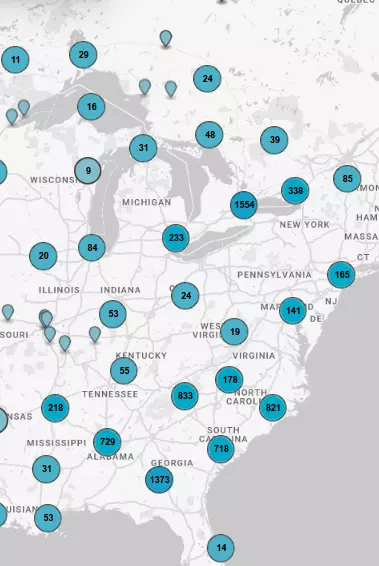Site of Norcross Presbyterian Church - Circa 1899
Originally chartered in 1833 by the Fairview Presbyterian Church of Lawrenceville, the church was originally located at the intersection of Beaver Ruin Road and Hopkins Mill Road on land donated...
- lat34
Site of Norcross Methodist Church - Ca. 1875
The origins of the Norcross Methodist Church date back to approximately 1818, when a small group of people formed a church named Medlock´s Chapel about 1 ½ miles southeast of what is now...
- lat34
Norcross Train Depot - Circa 1909
Norcross was founded as a railroad town in 1870 with the expansion of the Richmond-Danville Railroad out of Atlanta. It quickly became known as a restore town for vacationing Atlantans wishing to...
- lat34
National Register of Historic Places - City of Norcross
The Norcross Historic District has been preserved as a 19th century railroad town, and its historical significance has been recognized by the U. S. Department of the Interior through its listing...
- lat34
Jonathan Norcross
When Jonathan Norcross died on December 18, 1898, The Atlanta Constitution featured his picture on its front page, proclaiming him, "The Father of Atlanta" and "Atlanta's Most Historic Citizen"...
- lat34
Historic Baptist Church - Circa 1884
On May 17, 1872, seventeen people convened in the Community House on Church Street or "Holy Row," now called Sunset Drive, in the fledgling town of Norcross, renamed First Baptist Church of...
- lat34
Checkers Alley
On this site, through the early teens of the last century, there was an alley used to access businesses off of main street, including Arthur Maloney´s corn mill which was located in the...
- lat34
Aviation Tragedy
In the evening hours of December 6, 1953 four F-84D jet aircraft of 128th Fighter Bomber Squadron of the Georgia Air National Guard crashed near this site. They were returning from a...
- lat34
Elisha Winn House
This house was built by Elisha Winn around 1812. In 1818, the Georgia General Assembly created Gwinnett County from Cherokee and Creek cessions and part of Jackson County. The first...
- lat34
Lawrenceville Female Seminary
The first building erected on this property was completed July 31, 1838 to house the Lawrenceville Female Seminary. The Reverend John S. Wilson was elected first president of the Board of...
- lat34
Fort Daniel
Fort Daniel was completed in 1813 to protect the frontier from Indians aroused by the British during the War of 1812. Presumably named for General Allen Daniel, the fort was garrisoned by the 25th...
- lat34
Gwinnett County
Created in 1818 from Cherokee and Creek cessions, Gwinnett is an original county. Courts, elections, and sheriff sales were held, first, in the home of Elisha Winn, 1 mile east of the Appalachee...
- lat34
Garrard's Cavalry Raid
On July 20, 1864, Union forces under Maj. Gen. W.T. Sherman, USA, were closing in on Atlanta. Hq. 2nd Cavalry Division. Brig. Gen. Kenner Garrard, was in Decatur, 6 miles E of Atlanta....
- lat34
Peachtree Road
At Fort Daniel on Hog Mountain, about 12 miles NE, began the original Peachtree Road to the village of Standing Peachtree on the Chattahoochee River. This old road was opened to haul military...
- lat34
Button Gwinnett
Button Gwinnett, for whom this county was named, was born in Gloucestershire, England, in 1735, the son of a Church of England minister. He worked in the store of his father-in-law in Dexter for...
- lat34
White Plains Baptist Church
White Plains Baptist Church was organized in 1806, with all four sanctuaries located here. The current sanctuary was constructed in 1887. Welcoming its first African-American member in 1812, both...
- lat34
Blue Star Memorial
A tribute to the Armed Forces that have defended the United States of America SPONSORED BY Greensboro Garden Club IN COOPERATION WITH Georgia Department of Transportation and City...
- lat34
Great Buffalo Lick
This site is described in the Treaty signed by the Creek and Cherokee Indians at Augusta, Georgia, in 1773. Here began the survey of the ceded lands. WPA 1936 Plaque courtesy Lat34North.com....
- lat34
William C. Dawson 1798-1856
Statesman - soldier - jurist- Freemason A native of Greene County, then on Georgia´s Indian frontier, he was educated in the law and admitted to the bar in 1818. The remainder of his...
- lat34
Sheriff L.L. Wyatt [side 2]
(Continued from other side) moonshiners resisted arrest, Wyatt regularly shot it out with them. He killed over a half dozen men, all of whom shot at him first. The most famous gunfight of...
- lat34
